
Introduce cause/effect and input/output to students, then complete a related scavenger hunt.
- Subject:
- Computer Science
- Computing Systems
- Material Type:
- Lesson Plan
- Author:
- C. Hope Adams
- Emily Kidd
- Jennifer Nelson
- Date Added:
- 12/07/2021

Introduce cause/effect and input/output to students, then complete a related scavenger hunt.

This video is part of the Continue to Know with WHRO TV series. Watch Claire Verdillo teach about cause and effect relationships.

English Instructional Plan – Cause-and-Effect and its Impact on the Plot 6-8

Students will understand digital citizenship and the role they play as digital citizens.

Using a class text (longer text is preferred for better gameplay), students will create if/then statements that demonstrate cause and effect rEnglishtionships from their reading. Students will use these statements to guide the player through significant and impactful plot points of the story through the resource Twine.
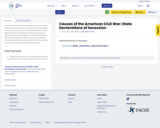
Students will read the declarations of secession from each state joining the CSA. Students can be assigned to read all, a few, or just one. Students will then draft a statement summarizing the reason(s) the state is giving for secession. Students can write/share these with the class and then discuss any commonalities among the statements to determine the cause of the Civil War according the states that seceded.
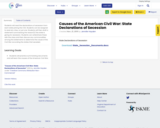
Students will read the declarations of secession from each state joining the CSA. Students can be assigned to read all, a few, or just one. Students will then draft a statement summarizing the reason(s) the state is giving for secession. Students can write/share these with the class and then discuss any commonalities among the statements to determine the cause of the Civil War according the states that seceded.

Students will read the declarations of secession from each state joining the CSA. Students can be assigned to read all, a few, or just one. Students will then draft a statement summarizing the reason(s) the state is giving for secession. Students can write/share these with the class and then discuss any commonalities among the statements to determine the cause of the Civil War according the states that seceded.
Remixed to include map.
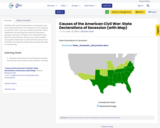
Students will read the declarations of secession from each state joining the CSA. Students can be assigned to read all, a few, or just one. Students will then draft a statement summarizing the reason(s) the state is giving for secession. Students can write/share these with the class and then discuss any commonalities among the statements to determine the cause of the Civil War according the states that seceded.
Remixed to include map.
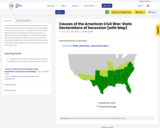
Students will read the declarations of secession from each state joining the CSA. Students can be assigned to read all, a few, or just one. Students will then draft a statement summarizing the reason(s) the state is giving for secession. Students can write/share these with the class and then discuss any commonalities among the statements to determine the cause of the Civil War according the states that seceded.
Remixed to include map.

Students will apply their knowledge of the causes of the American Revolution to create an interactive story via Twine. The interactive story will be based on the pre-revolutionary war period from the point of view of a loyalist or a patriot. As a warm-up students will look at an optical illusion picture and as a class discuss point of view and perspective. Students will work in heterogeneous pairs/groups to research, outline, and create a pre-revolutionary story about a patriot or loyalist.

Students will analyze multiple sources to determine which of the causes of the Civil War each source best supports. Students will support their choices with evidence from the source and their own understanding of the causes of the Civil War.
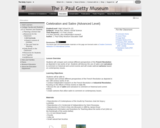
Students will compare and contrast different perspectives of the French Revolution as depicted in two works of art. Students will discuss the use of satire and caricature to comment on historical and current events and will create satirical cartoons based on contemporary issues.
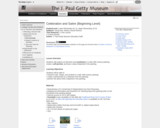
Students will analyze art elements and symbolism in a late-19th-century painting, create a self-portrait, and learn a dance depicted in the painting
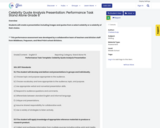
Students will create a presentation including images and quotes from a select celebrity or a celebrity of their choice. ** This performance assessment was developed by a collaborative team of teachers and division staff from Middlesex, Poquoson, and West Point school divisions.

It is often difficult for students to remember the functions of the cellular organelles because they cannot see, feel, or touch them. Presenting the analogy of the "Cell As A City" helps them realize that each organelle has an essential function. There is also a small section at the bottom of the resource asking the students to recall which cell parts are in a eukaryote, prokaryote, or both.
This worksheet will help your students demonstrate understanding of the concept after a lecture. It could also be used after a traditional organelles lecture, but before you have presented the analogy as a non-graded exercise.

In this 10 minute video Paul Andersen discusses cell communication. He begins by explaining how he communicates with other individuals using various forms of electronic communication. Included in this resource are a worksheet and full transcript of the video.
Transcript added from YouTube subtitles. You can use this to write your own worksheet or quiz.

In this 10 minute video Paul Andersen discusses cell communication. He begins by explaining how he communicates with other individuals using various forms of electronic communication. Included in this resource are a worksheet and full transcript of the video.
Transcript added from YouTube subtitles. You can use this to write your own worksheet or quiz.

Science Instructional Plans (SIPs) help teachers align instruction with the Science Standards of Learning (SOL) by providing examples of how the content and the scientific and engineering practices found in the SOL and curriculum framework can be presented to students in the classroom. This lesson includes the WIDA English Language Development Standards for ELs and differentiation through additional support for both ELs and other students.

Science Instructional Plans (SIPs) help teachers align instruction with the Science Standards of Learning (SOL) by providing examples of how the content and the scientific and engineering practices found in the SOL and curriculum framework can be presented to students in the classroom.